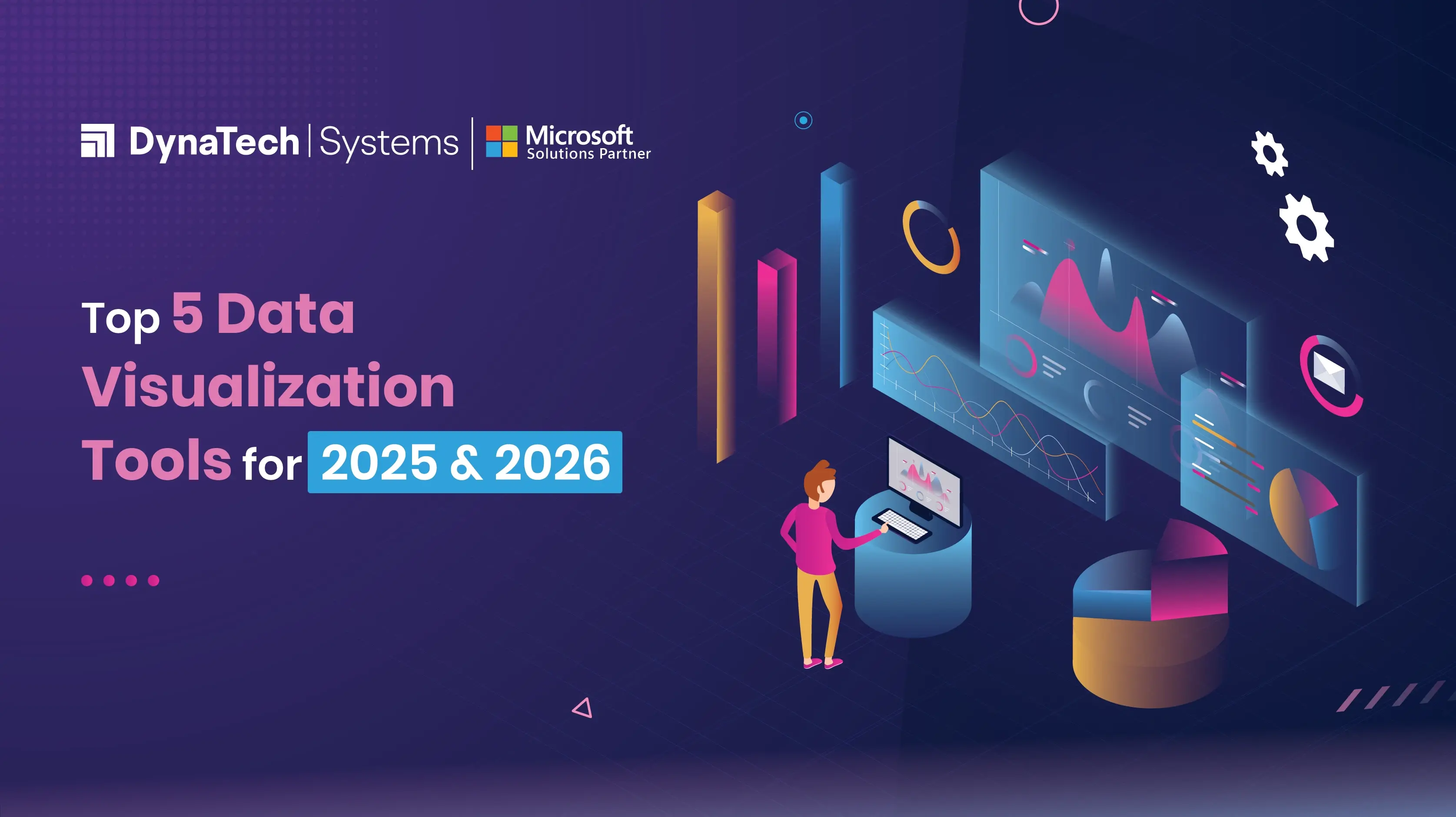Why Visualization Will Define the Next Decade of Data
From predictive analytics in healthcare to real-time sales insights in eCommerce, visual storytelling has evolved from dashboards to decision engines.
As the world generates over 328.77 million terabytes of data every day (Statista, 2024), raw tables and spreadsheets simply can’t keep up.
Decision-makers need tools that don’t just display data—they need platforms that interpret, engage, and drive action. If you are looking for the best data visualization service providers in the world, this blog is just for you.
That’s where the next generation of data analysis and visualization tools comes in.
In this blog, we deep-dive into the most advanced and best data visualization tools set to dominate 2025 and 2026. We don’t just list features—you’ll find real-world applications, strengths, drawbacks, expert opinions, and what makes each platform suitable for enterprises, startups, and data-heavy industries alike.
Whether you're a CIO, data scientist, business analyst, or product manager, these insights will help you choose the right tools for large data visualization that align with your business goals and technical infrastructure.
But before we explore the winners, let’s understand what makes a tool future-ready in the first place.
What Makes a Data Visualization Tool Ready for 2025 & 2026?
Choosing a visualization tool today isn’t just about pretty dashboards—it’s about speed, scale, and smart insights. As AI, real-time streaming, and multi-source integration become business norms, modern visualization platforms must evolve to meet these challenges.
Here are the must-have capabilities of future-ready tools:
AI-Augmented Analytics
Tools must go beyond charts and graphs. Natural language queries, anomaly detection, and AI-generated narratives are quickly becoming standard in the recent visualization technology 2025 era. Real-Time Data Streaming
In 2025, delays in decision-making mean missed revenue. Visualization tools must be capable of ingesting and displaying real-time data from IoT devices, CRMs, ERPs, and third-party apps—especially for logistics, finance, and manufacturing sectors. Support for Large and Complex Datasets
The ability to handle terabytes or even petabytes of data without performance lag is essential. Enterprises need tools for large data visualization that provide seamless performance with complex schemas, multiple joins, and high-volume queries. Cloud-Native Architecture
The future is serverless, and modern database visualization tools must be cloud-native, offering scalable infrastructure, hybrid deployment, and elastic compute for peak loads. Enterprise-Grade Governance & Security
Granular access controls, audit logs, role-based views, and compliance with standards like HIPAA, GDPR, and SOC 2 are not optional anymore. Seamless Integration with Enterprise Apps
Whether it’s connecting with Microsoft Dynamics 365, Salesforce, Azure Synapse, or Snowflake, a top-tier tool must play well within the enterprise ecosystem.
Now that we know the criteria, let’s explore the Top 5 Data Visualization Tools that meet (and exceed) these benchmarks in 2025 and 2026.
Top 5 Data Visualization Tools for 2025 and 2026
Power BI
Developed by Microsoft, Power BI is a data visualization tool that integrates seamlessly with other Microsoft products like Azure, Excel, and Dynamics 365. With a broad spectrum of visualizations and robust data modeling capabilities, Power BI is a popular choice for enterprises invested in the Microsoft ecosystem. Though the platform is relatively user-friendly, unlocking its full capabilities requires analytical and DAX skills.
Core features:
- Create dashboards and reports: Build visually rich dashboards using a simple drag-and-drop interface.
- Visualizations: Access a wide range of standard visuals like bar charts, tree maps, and KPIs, or create custom visuals using Power BI SDK.
- Change analysis: Analyze and interpret changes in data values with AI-generated insights.
- Data modeling: Use Power Query, Power Pivot, and DAX to cleanse data, build relationships, and define calculations.
Pros:
- Affordable pricing and tight integration with Microsoft tools.
- Ideal for Excel users with a short learning curve.
- Strong enterprise governance and security features.
Cons:
- Limited customization options compared to Tableau.
- Struggles with very large or complex data models.
- Some advanced analytics features require additional configuration or integration.
G2 Rating: 4.5/5
Pricing:
- 30-day free trial
- Free account
- Power BI Pro: $10/user/month
- Power BI Premium: $20/user/month
- Power BI Embedded: Pricing varies
DynaTech Insight: With DynaTech’s D365 Data and Analytics services, businesses can integrate Power BI deeply into their existing Dynamics environment, enabling real-time operational dashboards and predictive insights for finance, sales, and supply chain.
-
Qlik Sense
Or
Not every BI tool gives you the freedom to explore data without pre-set paths—and that’s where Qlik Sense stands out. Designed for users who want more control and less rigidity, it uses what’s called an “associative engine” to let you jump between data points, make unexpected connections, and spot trends you didn’t even know to look for.
Core Features:
- Dashboards aren’t just static here—they’re interactive, detailed, and surprisingly responsive even with complex queries.
- There’s a growing AI layer in Qlik Sense now. From asking questions in plain English to auto-generated insights, it's making life easier for analysts.
- The ability to connect to nearly any type of data source—cloud or local—is a huge plus for teams that don’t have centralized data yet.
- Associative engine uncovers hidden insights through intuitive exploration
- Supports complex, enterprise-wide deployments across data environments
- Embedded analytics and customizable dashboards
- Real-time automation improves decision-making speed
Pros:
- Associative engine uncovers hidden insights through intuitive exploration
- Supports complex, enterprise-wide deployments across data environments
- Embedded analytics and customizable dashboards
- Real-time automation improves decision-making speed
Cons:
- The learning curve is real—especially if you're not used to BI platforms.
- Setup and configuration take time and often need IT involvement.
- Pricing can feel steep for small and mid-sized teams.
G2 Rating: 4.4/5
Pricing:
- Free 30-day trial
- Qlik Sense Business: $30 per user/month
- Qlik Sense Enterprise SaaS: Custom pricing
Best suited for:
Teams in industries like manufacturing, finance, or healthcare—especially where real-time insights and complex data are part of daily decision-making.
Tableau
Tableau is a well-established business intelligence and analytics platform designed to help organizations explore, understand, and visualize their data. It allows users to connect to a variety of data sources and build interactive dashboards that convert raw numbers into insightful visuals. While Tableau is known for its flexibility and design control, it may present challenges for users who are unfamiliar with data structures or advanced analytics, particularly when handling large datasets.
Core Features
- Data connection and import: Supports seamless integration with databases, spreadsheets, cloud services, and web data connectors
- Data visualization: Offers a wide variety of visual elements such as bar charts, line graphs, scatter plots, and geo-maps
- Dashboard creation: Enables users to combine multiple visualizations into a single, interactive interface
- Data blending: Allows users to merge data from different sources for comprehensive analysis
Pros
- High degree of customization for building tailored dashboards and visuals
- Extensive support resources and an active user community
- Trusted by large enterprises for governance and scalability
Cons
- Steep learning curve, especially for users new to BI tools
- Cost may be prohibitive for startups or small teams
- Limited real-time data capabilities compared to some modern alternatives
G2 Rating: 4.4 / 5
Pricing
- 14-day free trial
- Tableau Creator: $75 per user/month
- Tableau Explorer: $42 per user/month
- Tableau Viewer: $15 per user/month
Zoho Analytics
Zoho Analytics is a cloud-based business intelligence platform built for users who need straightforward, efficient analytics without a steep learning curve. It offers an accessible way to prepare, visualize, and analyze data, making it especially attractive to small and medium-sized businesses that want to move beyond spreadsheets. With built-in AI and a growing library of pre-built reports, Zoho simplifies the process of drawing insights from multiple data sources.
Core Features
- Data integration: Seamlessly pull in data from spreadsheets, databases, and various cloud applications
- Data preparation: Perform calculations, merge datasets, and create custom metrics with minimal coding
- Visualization templates: Use ready-made chart, table, and dashboard formats to quickly build reports
- Augmented analytics: Built-in AI and machine learning help generate predictive insights and natural-language-based answers
Pros
- Excellent pricing for startups and growing teams
- Simple user interface with good cross-platform integration
- Ideal for teams transitioning from Excel to a more visual tool
Cons
- Customization options are limited for advanced users
- Doesn’t support real-time data streaming
- May face performance issues when working with large datasets
G2 Rating: 4.3 / 5
Pricing
- 15-day free trial
- Basic: $24/month for 2 users
- Standard: $48/month for 5 users
- Premium: $115/month for 15 users
- Enterprise: $455/month for 50 users
- Custom plans available for larger teams
SAP BusinessObjects
or
SAP BusinessObjects is an enterprise-grade business intelligence platform tailored for organizations that operate in complex data environments. It offers a comprehensive suite of tools for reporting, data analysis, and visualization, along with robust integration across SAP systems and third-party databases. BusinessObjects is designed to handle large volumes of data with a strong emphasis on governance, making it a popular choice for regulated industries and corporations with stringent compliance requirements.
Core Features
- Reporting tools: Create structured, interactive reports tailored to business departments or regulatory needs
- Data integration: Supports SAP-native connections along with non-SAP data platforms
- Data exploration: Drill into datasets for detailed trend and variance analysis
- Security and governance: Built-in access control, user management, and compliance tooling
Pros
- Designed for large-scale enterprise reporting and data security
- Excellent for compliance-driven industries needing full data governance
- Tight integration with SAP applications and infrastructure
Cons
- High licensing and setup costs may be a barrier for small to mid-sized businesses
- Complex configuration often requires ongoing IT involvement
- User interface can be unintuitive for non-technical users
G2 Rating: 3.8 / 5
Pricing
- Custom pricing based on infrastructure, deployment type, and licensing volume
Final Thoughts
No single data visualization tool fits everyone. Power BI works great if you're in the Microsoft space, Tableau offers unmatched design flexibility, and platforms like Qlik, Domo, or Zoho shine in specific use cases. For large enterprises, SAP BusinessObjects still holds its ground.
But tools alone don’t drive insights—how you implement and align them with your goals matters more.
At DynaTech, we help businesses turn scattered data into meaningful dashboards using solutions like Power BI and Dynamics 365. If you’re unsure where to begin or want more from your analytics setup, we’re here to help.




























